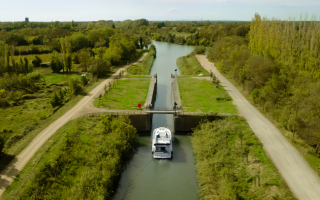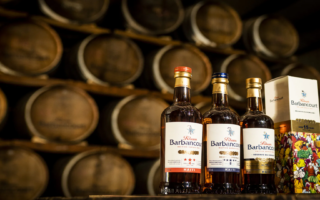Champagne for beginners
Champagne’s reputation precedes it, reinforcing its image as a toff’s tipple. Toby Shergold takes to the road in a bid to find the truth behind the bubbles…
Champagne has a reputation for being the drink of the elite – quaffed by the rich and famous at the opera, garden parties, the races and in Monte Carlo on private yachts. In recent years rappers and footballers have pushed the elitism to another level as they impress potential Wags with bottles of Cristal for �500 a pop. The rest of us plebeians think it’s only for special occasions. At least, that’s what I used to think.
So the prospect of a visit to the bubbly’s homeland was riling my inner socialist and the chip on my shoulder was a-twitching as my train sped across the countryside of northeast France. Visions of pretentious wine buffs were hard to put aside, nosing their wine and patronising those who were anything less than an expert. However, within 48 hours all those prejudices would be smashed like a toppled champagne flute as I was inducted into the reality of champagne in Champagne. Hidden behind a century of myth-making is a drink that, in its homeland, is far more egalitarian – made by down-to-earth family producers and drunk by local people after a hard day’s work.
As I walk down the Avenue de Champagne in the town of �pernay, known by many as the capital of champagne, there is nothing to dispel my elitist preconceptions. Locals say this broad street is the most expensive in the world because of the millions of bottles of champagne stored in the miles of chalk cellars beneath it. Home to the headquarters of a number of the drink’s most exclusive producers such as Mo�t et Chandon, Mercier and Perrier-Jou�t, each building is a bastion of exclusivity; beautiful and aloof mansions standing back from the road behind firmly closed wrought iron gates. Vive la revolution, comrades!
I was passing through the Avenue de Champagne on my way to a new establishment in �pernay, the owner of which is a man with a mission. After years of working for a top champagne house, Fr�d�ric Dricot is now championing an alternative idea of what champagne is about. Once he was part of Mo�t et Chandon’s marketing team helping to polish that gilded reputation – now he is spreading with evangelical zeal what he sees is the real story behind the drink he loves.
His C-Comme Champagne is half-bar, half-shop. New customers are invited to learn a little about champagne production and the people who produce it, sample anything that takes their fancy in the relaxed bar area and then hopefully purchase a few. With prices starting at €12 a bottle and not going much above €20, it is easier than you might think.
Very friendly people Dricot believes champagne should be accessible to everyone. C-Comme stocks champagne from 56 different producers – all of them small independents and many of them family-run businesses – and laid out simply with colour-coding referring to which region in Champagne they come from. “We are here to represent them,” says Dricot. “And we are very proud to. We have producers from many villages in the Champagne region so we are a good place to start if you want to know more. And we are very friendly people!”
I soon learn that, just like any other food or drink produced by many local businesses, there are myriad characters of champagne – varieties to be drunk as an ap�ritif, or with dinner, or after dinner, or even deep-flavoured ones that are perfect as a nightcap. The basis for the diversity lies in the three different types of grape used to produce champagne and how they are blended. Two of these are red wine grapes, the famous pinot noir and its lesser-known cousin, pinot meunier. In champagne production, the grapes are squeezed gently and quickly, and there is an absence of skin contact during fermentation so the juice only comes from its white flesh and is not coloured by the skins. Pinot noir contributes a robust body and complexity, pinot meunier offers fruity and floral aromas, while the third grape, chardonnay, has an elegant, light character. Some champagnes are made exclusively from chardonnay; these are blanc de blancs or white of whites’, and are the most delicate and driest of champagnes.
There is also the blanc de noirs, made only of black grapes, which is famed for its intense richness and full-bodied nature. Champagne produced solely from pinot noir can be found easily while 100 per cent pinot meunier is rare; the most common is a blend of the two. Most champagnes are a blend of two or three of the grapes and how these are combined adds to each vineyard’s distinct flavour. Many champagnes are not vintage and producers mix different years together to get the best results. Then there is that old French enigma, terroir – the soil, the weather, the elevation, the amount of sunlight – that also dictates the characteristic of each vineyard’s grapes. This is where Dricot feels the small producers have an advantage over the big corporations, which buy up grapes from all over the Champagne region and rely on expert blending to get the correct personality for their varieties. “I know the problem of big firms. I work with small ones because they are pure, they are real,” he espouses.
After a fascinating evening talking to Dricot, and I have fallen in love both with this new view of champagne and a particularly delicious blanc de noirs. I head off clutching a couple of bottles and he recommends I continue my education at La Cave, a champagne restaurant a few doors down. It has a menu of local cuisine where each dish is accompanied by a selected champagne. The experience is made all the more enjoyable now that I’m an expert’.
The following morning, a short drive from �pernay and I am in the C�tes des Blancs, one of the four major champagneproducing districts. At its heart is the small town of Le Mesnil-sur-Oger, home to the Launois family who, for six generations, have worked the land to produce renowned grand champagne made of grapes from only one vineyard. The latest owner, Bernard Launois, is a magpie for champagne artefacts and for 30 years he has been building a collection, which has developed into a museum dedicated to the wine’s history. It is a refreshingly oldfashioned museum, a warren of cellars packed with collections of everything champagne-related. The guide uses these items to weave the history of champagne from the days of Dom P�rignon onwards.
Disorientated by being led through one tunnel after another, I eventually step through a low door that is cut out of a giant barrel, and find myself in a rustic bar being presented with a glass of my new-found friend. This is a working vineyard after all, and the tour ends with a tasting. What is as refreshing as Launois’ blanc de blancs is that the tasting is not wrapped up in any of the pretentiousness I had feared. Before arriving in Champagne I would have worried about having to nose the wine effetely while claiming the ability to smell a dozen different scents – jasmine, bougainvillaea, newly cut grass, coal – and if I couldn’t guess the correct vintage I would be deported.
The reality is that after trying two or three of Launois’ fabulous varieties – again, all very reasonably priced – the only thing I’m tested with is deciding which one I prefer. But what is encouraging is that the three major champagne grapes (pinot noir, chardonnay and pinot meunier) are so distinctive, it is not that difficult to work out which blend of champagne each one is. I end up leaving with a couple of bottles.
On the trail A quick dash down the A26 to Troyes and beyond southwards – cutting out the large agricultural plain at the heart of Champagne that has few vineyards – takes you to the C�te de Bars, the southernmost wineproducing district. Here I pick up the trail of La Route du Champagne, which traces a narrow loop southwest, then northeast, up and down the C�te de Bars. I join it at Barsur- Seine and head into the depths of the C�te, crossing the rolling hills and picking my way through beautiful golden-stone villages dominated by the champagne trade. The journey is punctuated by roadside stone markers that denote who owns the vineyards, while each village plays host to several champagne houses.
After stopping off in Essoyes, the former home of Renoir, I head to Les Riceys, a town made of three villages – Ricey Bas, Ricey Haut and Ricey-Haut-Rive – which lie together in the shallow valley of the River Laignes at the southernmost tip of the C�te. The village centres are ringed by light industrial units that are home to the many champagne producers. This is no tourist trap centred on grand wine ch�teaux where visitors can look but not touch: these are small businesses at the heart of their community and upon which the community relies.
One such firm is Champagne Guy de Forez, run by Francis Wenner and his wife Sylvie, completely self-taught producers (he was previously a postman). They have named their business after one of the renowned historic names of Les Riceys who once owned the 17th-century house that is at the heart of their enterprise. Their friendly assistant Elizabeth is happy to show me around the cellars and enthusiastically explain the complex process behind champagne.
In the m�thode Champenoise, after the initial pressing and first round of fermentation, which now occurs in huge, deep steel tanks, the wine is bottled and then induced to ferment again by adding a mix of yeast and sugar. The bottles are laid down horizontally in the cellar to ferment for a minimum (by law) of 18 months. They are then placed on racks at 45� downwards so the dead yeast sediment (or lees) collects in the neck, which is called riddling’. Traditionally, every few days each bottle would need to be given a slight shake and turn, and dropped back into the rack, pushing sediments toward the neck of the bottle. The angle is steadily increased and after six to eight weeks the bottle is pointing straight down with sediment in the neck of the bottle.
Traditional vineyard cellars are lined with rows and rows of bottles being riddled, but many – as at Guy de Forez – now use huge machines that carry hundreds of bottles in a cage and turn them over the weeks. When the bottle is ready, the neck is frozen, and the cap removed. The pressure in the bottle forces out the lees, and the bottle is quickly corked to maintain the carbon dioxide that has built up in fermentation. This disgorging was a skilled manual process, where the cork and the lees were removed without losing large quantities of the liquid. Immediately after disgorging but before corking, the liquid level is topped up with liqueur d’exp�dition. It is common to add a little sugar, but the blend of this liqueur adds to different producers’ and varieties’ character, and some champagne brands have their own secret recipe, which can include old wine, cognac, port, fruit wines and tannins.
Elizabeth guided me through the journey of a bottle of champagne during our tour through the vineyard’s warehouse and cellars, seeing the different years’ vintages and the workers acting as nursemaids. We end with the now obligatory tasting.
That night I visit my hotel’s bar, determined to see what varieties of champagne they stock, but as I open the door the air is full of the banter of a group of workmen having a drink at the end of their day. I falter in my desire for champagne, worried about looking too posh, and decide to opt for a frothy French beer instead. That is until I notice all these working men are quaffing champagne – here in Les Riceys it’s the drink for a labourer at the end of his hard day’s work. This image explodes any final remaining prejudices about champagne. I now know that champagne doesn’t need to be reserved for special occasions and for those who can afford the big elitist brands. It is a drink of diverse tastes and varieties that can be enjoyed by anyone at anytime. I am now a champagne socialist.
Share to: Facebook Twitter LinkedIn Email


